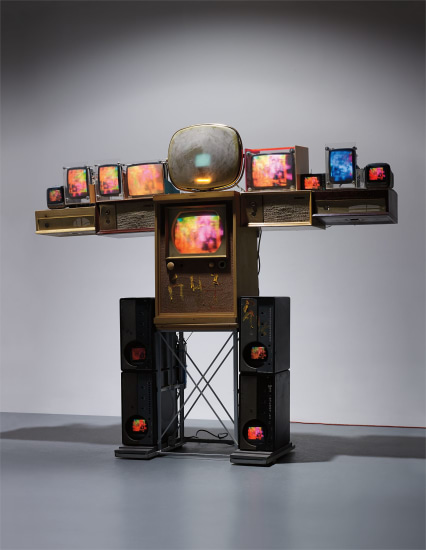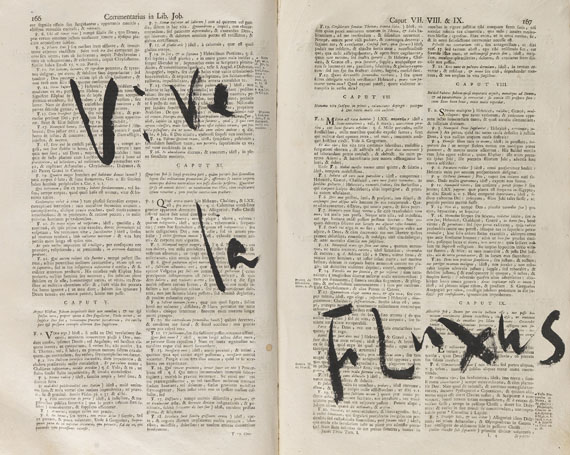Property of an Important American Collector Nam June Paik Follow Big Shoulder 1998 signed 'Nam June Paik [in Hanja] PAIK' on the front mixed media, antique cabinets, televisions, laser disc player and laser disc 233.7 x 264.2 x 45.7 cm (92 x 104 x 17 7/8 in.) Executed in 1998.
Provenance Private Collection (acquired directly from the artist in 1998) Private Collection, New Jersey Phillips, New York, 14 November 2014, Lot 268 Acquired at the above sale by the present owner Exhibited New York, Shin Gallery, Nam June Paik , 9 July - 31 August 2014 Catalogue Essay Towering over the viewer, Big Shoulder is one of Nam June Paik’s now-iconic robots. Executed in 1998, this imposing figure comprises television sets and antique furniture, wedded together to create this impressive monument. With its use of laser discs, the televisions themselves relay images that ensure that this sculpture is dynamic, constantly-changing, animated and almost alive. Paik was one of the great artistic pioneers of the second half of the Twentieth Century, one of the earliest adopters of video art. He was a prominent member of the Fluxus group, and worked alongside some of the most groundbreaking artists of his age, including Joseph Beuys John Cage and Allan Kaprow A virtuoso pianist, Paik would often incorporate music into his works, as well as performance in his ‘Happenings’. One of his greatest innovations was his use of televisions and the surrounding video technology, which he harnessed from the 1960s onwards. Paik made clothes and furniture that featured televisions, commenting on the potential of the medium. Big Shoulder continues that exploration of the role of the television, of visual information, in the modern world. The fusion of the television sets with the antique furniture that has been used to house them and form the bulk of Big Shoulder bridges the past and the present, and introduces the future. This robot continues a theme explored in his 1964 work, Robot K-456 , now in the Flick Collection at the Hamburger Bahnhof, Berlin. That work was a skeletal, remote-controlled robot which took its name from a work by Wolfgang Amadeus Mozart. It was designed to walk, move its arms, play clips of speeches made by the recently-assassinated President John F. Kennedy, and even defecated on command, ejecting beans. Paik would return a number of times to the theme of the robot that fuses the anthropomorphic and the technological. For instance, in 1986, he made his Family of Robot , of which the Father and Mother are now in the Nagoya City Art Museum, while the Baby is in the Art Institute of Chicago. While the ‘offspring’ was constructed out of aluminium furniture and television sets to give a ‘newborn’ appearance, the ‘parents’ were made by retasking vintage radio sets and antique furniture, like Big Shoulder . This gives the sculpture a sense of age, weathering and experience that is deliberately at odds with the visual effects on the screens. It reflects Paik’s fascination with the way that new media could link humanity and engage from day to day, bringing about a new change in our interactions with the world. By the time that Paik made Big Shoulder , he was an internationally-recognised artist. Indeed, in 1993, his exhibition in the German Pavilion at the Venice Biennale had won the Golden Lion. In 1998, he received the highly coveted Kyoto Prize, a distinction received by Roy Lichtenstien, Tadao Ando among many others. Read More Catalogue Essay 聳立於觀者面前的《大肩膀》,是白南準標誌性的機器人系列作品之一。本件作品創作於1998年,由電視機、古董傢俱等組合成碩大機器人形象,塑造出奪人氣勢。通過激光唱片,電視機轉播的畫面營造出雕塑時刻變化的動感,栩栩如生。作爲二十世紀下半葉的藝術先驅,白南準是最早採用影像作爲創作形式的藝術家之一。他是激浪派藝術運動的傑出成員,並與其同時代最具開創性的藝術家們並肩作戰,包括約瑟夫·博伊斯、約翰·凱吉、艾倫‧卡普羅等人在內。作爲一位受過正規訓練的鋼琴演習者,白南準時常將音樂融入其作品,並將表演融入其偶發藝術中。自1960年以來白南準善用電視機及其相關影像技術,成爲他偉大創新之一。白南準製作過描繪電視機的衣服和傢俱,藉此探索此類媒介的無限可能。《大肩膀》延續了對電視機和視覺信息在當今世界所扮演角色的探索。 電視機和古典傢俱的融合,不僅勾勒出《大肩膀》的體量特徵,而且承古容今、展望未來。此件作品延續了白南準於1964年創作的《機器人K-456》所探索的主題,該件作品現藏於柏林漢堡車站現代美術館的Flick收藏。骷髏形態的遠程遙控機器人能走能動,作品名源自莫扎特的曲目,播放當時剛遭遇刺殺的肯尼迪總統的演講片段,甚至能依指令排泄,噴射出豆子。白南準隔一段時間便會重回創作機器人的主題,妙用擬人化與科技感的融合。例如其1986年的作品《機器人之家》,其中《父與母》現藏於名古屋市美術館,而《孩子》現藏於芝加哥藝術博物館。《孩子》由鋁製傢俱和電視機組成,頗有新生兒之貌,而《父與母》則由重組的復古收音機和古董傢俱組成,如同《大肩膀》一樣。這旨在賦予雕塑年代和歲月感,特意與屏幕上播放的視覺效果形成對比。作品反映出白南準着迷於新媒體與人性及日常生活的千絲萬縷聯繫,爲大衆與世界互動的方式帶來前所未有的改變。 白南準創造《大肩膀》時,已是國際知名的藝術家。1993年,他於威尼斯雙年展德國館的展覽
Property of an Important American Collector Nam June Paik Follow Big Shoulder 1998 signed 'Nam June Paik [in Hanja] PAIK' on the front mixed media, antique cabinets, televisions, laser disc player and laser disc 233.7 x 264.2 x 45.7 cm (92 x 104 x 17 7/8 in.) Executed in 1998.
Provenance Private Collection (acquired directly from the artist in 1998) Private Collection, New Jersey Phillips, New York, 14 November 2014, Lot 268 Acquired at the above sale by the present owner Exhibited New York, Shin Gallery, Nam June Paik , 9 July - 31 August 2014 Catalogue Essay Towering over the viewer, Big Shoulder is one of Nam June Paik’s now-iconic robots. Executed in 1998, this imposing figure comprises television sets and antique furniture, wedded together to create this impressive monument. With its use of laser discs, the televisions themselves relay images that ensure that this sculpture is dynamic, constantly-changing, animated and almost alive. Paik was one of the great artistic pioneers of the second half of the Twentieth Century, one of the earliest adopters of video art. He was a prominent member of the Fluxus group, and worked alongside some of the most groundbreaking artists of his age, including Joseph Beuys John Cage and Allan Kaprow A virtuoso pianist, Paik would often incorporate music into his works, as well as performance in his ‘Happenings’. One of his greatest innovations was his use of televisions and the surrounding video technology, which he harnessed from the 1960s onwards. Paik made clothes and furniture that featured televisions, commenting on the potential of the medium. Big Shoulder continues that exploration of the role of the television, of visual information, in the modern world. The fusion of the television sets with the antique furniture that has been used to house them and form the bulk of Big Shoulder bridges the past and the present, and introduces the future. This robot continues a theme explored in his 1964 work, Robot K-456 , now in the Flick Collection at the Hamburger Bahnhof, Berlin. That work was a skeletal, remote-controlled robot which took its name from a work by Wolfgang Amadeus Mozart. It was designed to walk, move its arms, play clips of speeches made by the recently-assassinated President John F. Kennedy, and even defecated on command, ejecting beans. Paik would return a number of times to the theme of the robot that fuses the anthropomorphic and the technological. For instance, in 1986, he made his Family of Robot , of which the Father and Mother are now in the Nagoya City Art Museum, while the Baby is in the Art Institute of Chicago. While the ‘offspring’ was constructed out of aluminium furniture and television sets to give a ‘newborn’ appearance, the ‘parents’ were made by retasking vintage radio sets and antique furniture, like Big Shoulder . This gives the sculpture a sense of age, weathering and experience that is deliberately at odds with the visual effects on the screens. It reflects Paik’s fascination with the way that new media could link humanity and engage from day to day, bringing about a new change in our interactions with the world. By the time that Paik made Big Shoulder , he was an internationally-recognised artist. Indeed, in 1993, his exhibition in the German Pavilion at the Venice Biennale had won the Golden Lion. In 1998, he received the highly coveted Kyoto Prize, a distinction received by Roy Lichtenstien, Tadao Ando among many others. Read More Catalogue Essay 聳立於觀者面前的《大肩膀》,是白南準標誌性的機器人系列作品之一。本件作品創作於1998年,由電視機、古董傢俱等組合成碩大機器人形象,塑造出奪人氣勢。通過激光唱片,電視機轉播的畫面營造出雕塑時刻變化的動感,栩栩如生。作爲二十世紀下半葉的藝術先驅,白南準是最早採用影像作爲創作形式的藝術家之一。他是激浪派藝術運動的傑出成員,並與其同時代最具開創性的藝術家們並肩作戰,包括約瑟夫·博伊斯、約翰·凱吉、艾倫‧卡普羅等人在內。作爲一位受過正規訓練的鋼琴演習者,白南準時常將音樂融入其作品,並將表演融入其偶發藝術中。自1960年以來白南準善用電視機及其相關影像技術,成爲他偉大創新之一。白南準製作過描繪電視機的衣服和傢俱,藉此探索此類媒介的無限可能。《大肩膀》延續了對電視機和視覺信息在當今世界所扮演角色的探索。 電視機和古典傢俱的融合,不僅勾勒出《大肩膀》的體量特徵,而且承古容今、展望未來。此件作品延續了白南準於1964年創作的《機器人K-456》所探索的主題,該件作品現藏於柏林漢堡車站現代美術館的Flick收藏。骷髏形態的遠程遙控機器人能走能動,作品名源自莫扎特的曲目,播放當時剛遭遇刺殺的肯尼迪總統的演講片段,甚至能依指令排泄,噴射出豆子。白南準隔一段時間便會重回創作機器人的主題,妙用擬人化與科技感的融合。例如其1986年的作品《機器人之家》,其中《父與母》現藏於名古屋市美術館,而《孩子》現藏於芝加哥藝術博物館。《孩子》由鋁製傢俱和電視機組成,頗有新生兒之貌,而《父與母》則由重組的復古收音機和古董傢俱組成,如同《大肩膀》一樣。這旨在賦予雕塑年代和歲月感,特意與屏幕上播放的視覺效果形成對比。作品反映出白南準着迷於新媒體與人性及日常生活的千絲萬縷聯繫,爲大衆與世界互動的方式帶來前所未有的改變。 白南準創造《大肩膀》時,已是國際知名的藝術家。1993年,他於威尼斯雙年展德國館的展覽










.jpg)



Try LotSearch and its premium features for 7 days - without any costs!
Be notified automatically about new items in upcoming auctions.
Create an alert